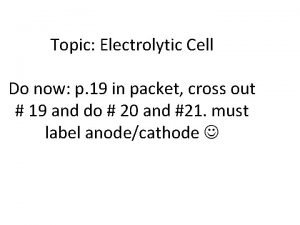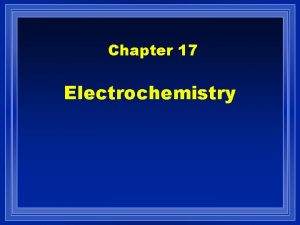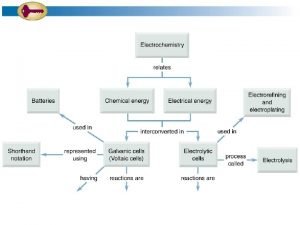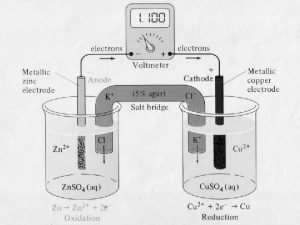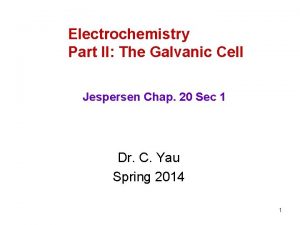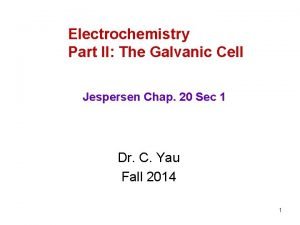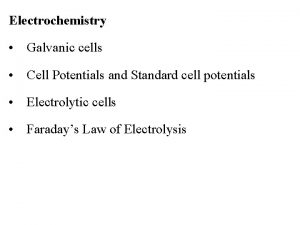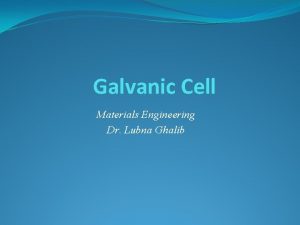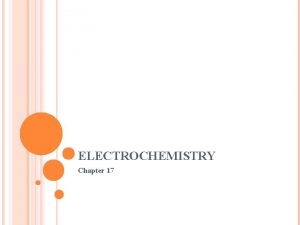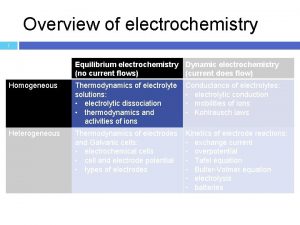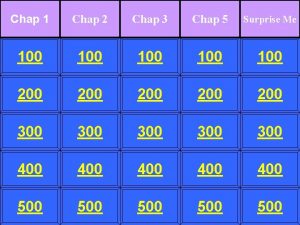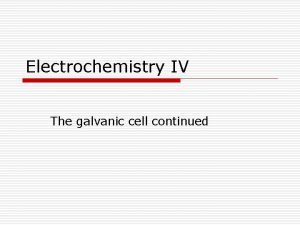Electrochemistry Part II The Galvanic Cell Jespersen Chap



















- Slides: 19

Electrochemistry Part II: The Galvanic Cell Jespersen Chap. 20 Sec 1 Dr. C. Yau Spring 2014 1

What is a Galvanic Cell? • A galvanic cell is a spontaneous electrochemical cell in which electricity is produced by a spontaneous redox reaction. • The resulting electron transfer is forced to take place through a wire. • It is also known as a voltaic cell. • Do not confuse it with the electrolytic cell (discussed later) where an electrochemical reaction is forced to take place by passing electricity through the cell. 2

Comparison of Types of Cell Galvanic or Voltaic Cell: Spontaneous electrochemical rxn Electricity produced Electrolytic Cell: Non-spontaneous electrochemical rxn Electric current is passed thru a wire to force the reaction to take place. 3

Anatomy Of A Galvanic Cell e- e- Note: Textbk is inconsistent with cathode which is on the left anode (cathode or anode). There is no convention which is on the left side in a sketch of this sort. Zn 2+ + 2 e− Cu 2+ (aq) + 2 e− Cu (s) • Half-cells (compartments containing reactants for each halfreaction) • Electrodes to conduct current through the solution. • Salt bridge to allow ion movement to keep solns neutral. • Supporting electrolyte (spectator ions: NO 3 -) 4 • Connecting external circuit (wire and voltmeter)

Electrochemical Cells • In all cells, electrons transfer between the cathode (the reduction half-cell) and the anode (the oxidation half-cell) REMEMBER! "Red-Cat and An-Ox” Reduction at the Cathode & Oxidation at the Anode 5

A closer look at the electrodes: Cu cathode Zn anode Zn 2+ Cu 2+ Zn 2+ Oxidation of Zn to Leaves e- behind on the electrode (soln becomes more positive) Cu Cu 2+ Zn 2+ Cu 2+ Reduction of Cu 2+ to Cu e- extracted from electrode (soln becomes 6 more negative)

Electrochemical Cells • Electrical current is conducted via the movement of electrons and ions. • To prevent charge buildup, a salt bridge allows ions to move between the cells. REMEMBER! • Electrons flow from anode to cathode through the wire. a to c • Cations move towards the cathode. • Anions move towards the anode. • Red-Cat and An-Ox. 7

KCl or KNO 3 Zn Cu Zn 2+ There is a buildup of what charges at each cell? The salt bridge often made of KCl or KNO 3 (unreactive ions – spectator ions) What ions in the salt bridge move to which cell? 8

Towards which compartment will electrons flow in an electrochemical cell? A. Toward the cathode anode to cathode B. Toward the anode C. It depends on the reaction Through which components of the cell will ions not flow? A. The electrodes B. The solution C. The salt bridge http: //www. mhhe. com/physsci/chemistry/essentialc hemistry/flash/galvan 5. swf 9

Standard Cell Notation (Line Cell Notation) anode salt bridge cathode Zn (s) | Zn 2+ (aq) || Cu 2+ (aq) | Cu (s) anode electrode electrolyte cathode electrode • Cell reactions separated by || that represents the salt bridge with ANODE on left, CATHODE on right. • Electrodes appear at the outsides • Reaction electrolytes in inner section • Phases (phys. States) separated with | • Species in the same state separated with ; • Concentrations shown in ( ) 10

Standard Cell Notation (Line Cell Notation) Write the half reactions for the galvanic cell shown above. Cu (s) Cu 2+ (aq) + 2 e. Ag+ (aq) + e. Ag (s) Make a sketch of the galvanic cell and label it fully. 11

Now, consider the reaction of Al 3+(aq) + Zn (s) Al(s) + Zn 2+(aq) Write the half-reactions. Balance the electrons and write the balanced net ionic equation. Sketch the galvanic cell (electrochemical cell). Label it fully. Write the standard cell notation. Do Prac Exer 1 & 2 on p. 924 12

Given: Mg(s) | Mg 2+(aq) || Sn 2+(aq) | Sn(s) Sketch the galvanic cell corresponding to this standard cell notation. Label it fully. Practice with p. 969 #20. 50, 20. 51 13

Now, consider the reaction of Fe 3+ + Zn Fe 2+ + Zn 2+ Write the half-reactions. Balance the electrons and write the balanced net ionic equation. Write the standard cell notation. Sketch the galvanic cell (electrochemical cell). Label it fully. How can you have an electrode that is an ion (such as Fe 3+)? 14

Where there are no conductive metals involved in a process, an inert electrode is used. C(gr) and Pt are often used. 2 Fe 3+ + Zn Zn (s) 2 Fe 2+ + Zn 2+(aq) Fe 3+(aq) Fe 2+(aq) Zn(s) |Zn 2+(aq) || Fe 3+(aq); Fe 2+(aq)|Pt(s) Zn anode inert cathode (where Fe 3+ reduces to Fe 2+ at the surface of the Pt electrode) 15

Balance and identify the cathode and anode H 2 O 2(aq) + CO 2(g) → H 2 C 2 O 4(aq) + O 2(g) (acidic) §H 2 O 2(aq) → O 2(g) +2 H+ + 2 eoxid § 2 H+ + 2 e- + 2 CO 2(g) → H 2 C 2 O 4(aq) + (acidic)reduc H 2 O 2(aq) + 2 CO 2(g) → H 2 C 2 O 4(aq) + O 2(g) (acidic) Which is at the cathode? At the anode? 16

Write Line Notation for the cell: H 2 O 2(aq) + CO 2(g) → H 2 C 2 O 4(aq) + O 2(g) (acidic) oxidation reduction Standard Cell notation for the reaction: C(gr)| H 2 O 2(aq) ; H+|O 2(g)||CO 2(g)|H 2 C 2 O 4(aq); H+|C(gr) 17

Balance and identify the cathode and anode Cr. O 3(s) + Mn. O 2(s)→Mn. O 4 -(aq) + Cr 3+(aq) (basic) Cr. O 3(s) + 3 H 2 O(l) + 3 e- → Cr 3+(aq) +6 OH-(aq) Mn. O 2(s) + 4 OH- → Mn. O 4 -(aq) + 2 H 2 O + 3 e- Cr. O 3(s) + Mn. O 2(s) + H 2 O(l) →Mn. O 4 -(aq) + Cr 3+(aq) + 2 OH-(aq) Balancing redox equations by half-reaction method is given in Sec 6. 2 (p. 222) 18

Galvanic Cells without Metal Electrodes Equation from previous slide: Cr. O 3(s)+ Mn. O 2(s) + H 2 O(l) →Mn. O 4 -(aq)+Cr 3+(aq) + 2 OH-(aq) Write the Standard Cell Notation: C(gr); Mn. O 2(s)|Mn. O 4 -(aq)||Cr. O 3(s)|Cr 3+(aq); OH-|C(gr) p. 970 #20. 52 19
 Chap chap slide
Chap chap slide The cell reaction for the zn-h2 cell is
The cell reaction for the zn-h2 cell is Chapter 21 electrochemistry
Chapter 21 electrochemistry Is the anode negative
Is the anode negative Nernst equation
Nernst equation Parts of a galvanic cell
Parts of a galvanic cell Galvanic cell inert electrode
Galvanic cell inert electrode Cathode oxidation or reduction
Cathode oxidation or reduction Electrolysis khan academy
Electrolysis khan academy Galvanic body spa results
Galvanic body spa results Cell notation
Cell notation Pamela fishman gender theory
Pamela fishman gender theory Digital tryk
Digital tryk Integrated rate equation
Integrated rate equation Laws jespersen
Laws jespersen Laws jespersen
Laws jespersen Kristina risom jespersen
Kristina risom jespersen Cell chap 14
Cell chap 14 Half reduction reaction
Half reduction reaction Galvanic facial aftercare advice
Galvanic facial aftercare advice



